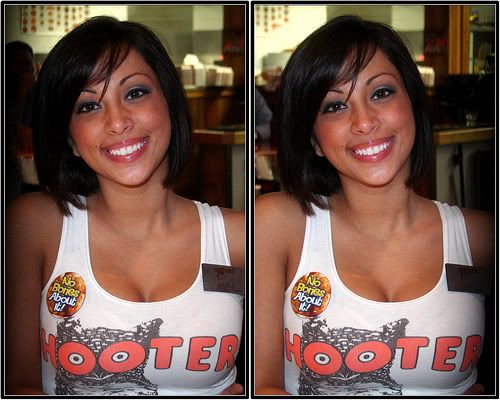I've posted some 3D pics recently. Been taking them for years now but as sometimes my brain runs like a truck with square wheels, only recently did it occur to me to actually do them on the site here. (Talk about a D'uh moment.....). For you guys/gals out there, I figure some of you are asking just why you should go through the extra effort of learning to cross your eyes in order to see the 3D effect. I mean some people never can do it and some people will always find it more difficult or a strain on the eyes. What's the big deal or reward for doing a Marty Feldman impression anyways??? (Marty was Igor in the "Young Frankenstein" movie: rent it. You'll be glad you did.)
Regular 2D photos are ok. Plenty of times that plain old text descriptions are not enough to get the point across. So a picture gives the reader/viewer a chance to "see what you're talking about." Especially if one is describing a procedure like doing the second gear repair. Helps the reader to follow along in a "just where the heck are we now?" kinda way. That's all about orientation: seeing where something is at by recognizing something in the picture that we already recognize. Or possibly seeing something in the picture that is different from what we've already seen in real life with our own eyes: Comparision. That "already been there" factor is what makes the 2D photo work for us enough so that we "get it" enough to understand what is in the picture. Hopefully enough to be able do the repair ourselves or to learn from other people's mistakes: (Insert picture of bent valves due to cam chain jumping a tooth....HERE.)
3D photos are ok too. But they are especially good in those situations where the reader/viewer has never seen the object in the picture before. 3D photos are the next best thing to having the object right there in front of your face. For example, hand some part from your bike over to someone who's never seen it before and watch what they do. If they're interested in the part then they will hold it in their hand, look at it, and then turn it around a bit to see it from a few different angles. Once they've done this they'll hand it back to you hopefully. That simple action of turning the item around and looking at it is all it takes for their stereo vision to allow their brain to make a 3D model of it inside their heads. They now Know what it looks like even if they're clueless as far as what it does or where it is normally installed on the bike. If some object is too big to hold in their hand and manipulate, then they'll either walk around it or move their head around in order to really "see" what something is if it is new to them. Once they've "seen" something in this stereo manner then you can show a picture of it to them later and more often than not they will recall/remember it. But that is only after they've seen it in real life and KNOW what it looks like: the shape, the size, the texture, the color, and how it looks from different angles in PERSPECTIVE. Learning how to cross one's eyes and see the 3D version of an object/part automatically gives the viewer the opportunity to "jump" to this level of understanding.
I've got an XS1100 but there's still repairs that I haven't done...things I haven't seen yet. Hasn't been the need thus far. When I do go into it for something necessary I'll take 2D pics, 3D pics, and even do videos when I feel that it would be of benefit to the other members. I'm a "visual" kinda guy anyways. But there's also the factor that I see these bikes as beautiful machines and all of the individual parts as visually interesting as well. Each component is a work of engineering "Art."
I apologize in advance for those about to "suffer the slings and arrows of outrageous" eyestrain.......
Regular 2D photos are ok. Plenty of times that plain old text descriptions are not enough to get the point across. So a picture gives the reader/viewer a chance to "see what you're talking about." Especially if one is describing a procedure like doing the second gear repair. Helps the reader to follow along in a "just where the heck are we now?" kinda way. That's all about orientation: seeing where something is at by recognizing something in the picture that we already recognize. Or possibly seeing something in the picture that is different from what we've already seen in real life with our own eyes: Comparision. That "already been there" factor is what makes the 2D photo work for us enough so that we "get it" enough to understand what is in the picture. Hopefully enough to be able do the repair ourselves or to learn from other people's mistakes: (Insert picture of bent valves due to cam chain jumping a tooth....HERE.)
3D photos are ok too. But they are especially good in those situations where the reader/viewer has never seen the object in the picture before. 3D photos are the next best thing to having the object right there in front of your face. For example, hand some part from your bike over to someone who's never seen it before and watch what they do. If they're interested in the part then they will hold it in their hand, look at it, and then turn it around a bit to see it from a few different angles. Once they've done this they'll hand it back to you hopefully. That simple action of turning the item around and looking at it is all it takes for their stereo vision to allow their brain to make a 3D model of it inside their heads. They now Know what it looks like even if they're clueless as far as what it does or where it is normally installed on the bike. If some object is too big to hold in their hand and manipulate, then they'll either walk around it or move their head around in order to really "see" what something is if it is new to them. Once they've "seen" something in this stereo manner then you can show a picture of it to them later and more often than not they will recall/remember it. But that is only after they've seen it in real life and KNOW what it looks like: the shape, the size, the texture, the color, and how it looks from different angles in PERSPECTIVE. Learning how to cross one's eyes and see the 3D version of an object/part automatically gives the viewer the opportunity to "jump" to this level of understanding.
I've got an XS1100 but there's still repairs that I haven't done...things I haven't seen yet. Hasn't been the need thus far. When I do go into it for something necessary I'll take 2D pics, 3D pics, and even do videos when I feel that it would be of benefit to the other members. I'm a "visual" kinda guy anyways. But there's also the factor that I see these bikes as beautiful machines and all of the individual parts as visually interesting as well. Each component is a work of engineering "Art."
I apologize in advance for those about to "suffer the slings and arrows of outrageous" eyestrain.......















Comment